Where to see 15 rare animals in national wildlife refuges
Our refuge system provides habitat for many species
On March 14, 1903, President Theodore Roosevelt established what is considered the first national wildlife refuge. Now, hundreds of refuges later, these protected areas are among the very best places to see rare wildlife.
President Roosevelt’s creation of the Pelican Island National Wildlife Refuge in Florida enjoys a prominent place in conservation lore, both for the public lands precedent it set and the rather forthright way he did it. But beyond this, it paved the way for a popular movement that valued wildlife in its own right, encouraged curiosity about how different flora and fauna lived and sought to check the effects of habitat loss.
Today, under the authority of the U.S. Fish and Wildlife Service, the National Wildlife Refuge System has more than 560 units, protecting (and in some cases restoring) about 150 million acres as habitat for thousands of species, many threatened or endangered. National wildlife refuges can be found in every state, comprising a multi-billion dollar economic engine that draws tens of millions of visitors each year. More than 20 million acres of these incredible landscapes are also part of the National Wilderness Preservation System.
Recent hardships--exemplified by the cancellation of National Wildlife Refuge Week in 2013 due to the government shutdown, as well as chronic budget shortfalls--have only underscored the importance of these places for conservation and education. Here are 15 extraordinary animals from the USFWS database, iconic and obscure alike, and some of the refuges where you might be able to spot them (if you’re lucky).
American crocodile

Credit: flickr, Sergey Yeliseev.
Status: Threatened in Florida, Endangered in other states.
Where to see it: J.N. “Ding” Darling National Wildlife Refuge (Florida),Crocodile Lake National Wildlife Refuge (Florida), Ten Thousand Islands National Wildlife Refuge (Florida).
Bigger and less-common than its cousin, the American alligator, the American crocodile is primarily found in South Florida, where a small population resides in swamps, coastal lagoons and estuaries. Some good news: though seldom seen and once very close to extinction, the prehistoric-looking giants have made a comeback in recent years. Despite their fearsome appearance, these reptiles, which grow up to 13 feet in length in the U.S., rarely attack humans (in fact, they tend to avoid us altogether). For fellow wildlife, it’s a different story: their muscular jaws are suited for preying on most fish, turtles, birds and small mammals.
Red wolf

Credit: flickr, Jim Liestman
Status: Endangered
Where to see it: Alligator River National Wildlife Refuge (North Carolina),Pocosin Lakes National Wildlife Refuge (North Carolina), Cape Romain National Wildlife Refuge (South Carolina).
The red wolf, like many other threatened and endangered species, was once common in the U.S., but habitat loss and other factors during the early 20th century took their toll, leaving the U.S. Fish and Wildlife Service to develop a last-ditch breeding program and bring the predators back from the brink of dying out entirely The agency did this using a few red wolves recovered from Texas and Louisiana, eventually reintroducing the offspring to a national wildlife refuge in North Carolina. Now, more than 30 years after they were officially declared extinct, that state, part of the historical range, contains more than 100 animals.
Hawaiian monk seal
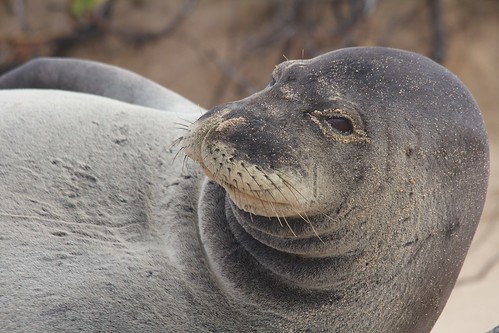
Credit: flickr, Mike Dunford.
Status: Endangered
Where to see it: Kilauea Point National Wildlife Refuge (Hawaii), Hawaiian Islands National Wildlife Refuge (Hawaii).
The beloved, besieged Hawaiian monk seal can grow to 450 pounds and has jaws suited to cracking crab shells with ease. However, it remains utterly at the whim of habitat loss and indiscriminate fishing operations, which have helped make it one of the most endangered marine mammals in the world. Found only in U.S. waters, the big predator is referred to as Ilio holo I ka uaua, or “the dog that runs in the rough water,” by native Hawaiians. Without a doubt, that vaguely canine appearance has helped buoy its public standing as a loveable beach-dweller.
Karner blue butterfly
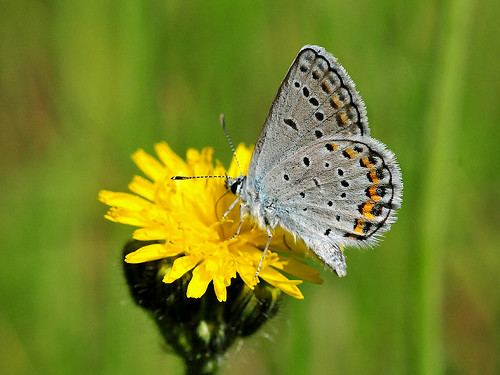
Credit: flickr, U.S. Fish and Wildlife Service - Midwest Region.
Status: Endangered
Where to see it: Necedah National Wildlife Refuge (Wisconsin)
These butterflies’ larvae feed only on the leaves of the wild lupine plant, greatly restricting their range. As a result, habitat loss has wreaked havoc on the species, its numbers dwindling nearly to extinction in the past 15 years. To compound that, the tiny, delicately-patterned adults are a coveted catch for butterfly collectors--and the collection of even a few can significantly impact the broader population. Recently, conservation measures in national wildlife refuges and zoos have helped reintroduce the Karner blue butterfly to its historic home range.
California Condor
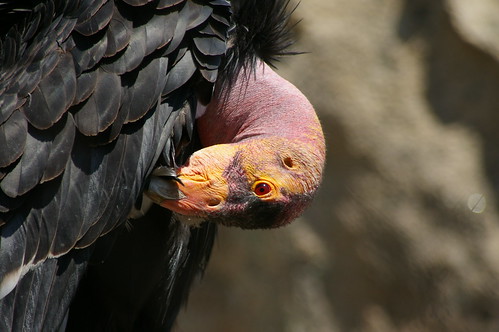
Credit: flickr, primatewrangler.
Status: Endangered
Where to see it: Bitter Creek National Wildlife Refuge (California), Blue Ridge National Wildlife Refuge (California), Hopper Mountain National Wildlife Refuge(California).
A huge, regal bird whose name is almost synonymous with back-from-the-brink conservation success stories, the California condor is nonetheless perpetually on the brink of extinction, with only a few hundred birds left in the wild. National wildlife refuges and other protected public lands like Pinnacles National Parkare especially important for their survival, as condors tend to do better in areas with controlled human intrusion and less development. Bald-headed and jowly, these scavengers are not conventionally beautiful, but their presence bespeaks a dinosaur-like mystique, and any birdwatcher would be extremely fortunate to see one in the flesh.
Humpback whale
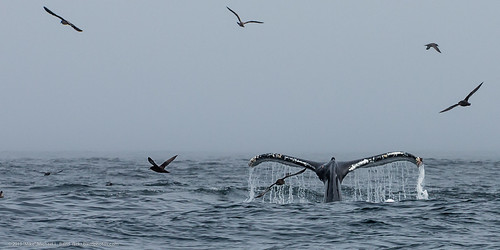
Credit: flickr, Mike Baird.
Status: Endangered
Where to see it: Alaska Maritime National Wildlife Refuge (Alaska), Kodiak National Wildlife Refuge (Alaska).
Despite their massive bulk, humpback whales are closely associated with a penchant for moving--specifically, the annual migrations that take them thousands of miles from tropical or subtropical waters (their wintertime calving grounds) back north to feed. Though they can be found in every major ocean, the 25-to-40-ton filter-feeders face threats including whaling, accidental boat collision and entanglement in commercial fishing equipment. Fortunately, their numbers are increasing in much of their range, and with continuing conservation efforts, their eerie “songs,” meant to attract mates or challenge rivals, will hopefully not be silenced any time soon.
Jaguarundi (Texas)

Credit: flickr, Fábio Manfredini.
Status: Endangered (possibly extinct)
Where to see it: Lower Rio Grande Valley National Wildlife Refuge (Texas), Laguna Atascosa National Wildlife Refuge (Texas), Santa Ana National Wildlife Refuge (Texas).
You might catch a glimpse of the sinuous, dusky Jaguarundi somewhere in Florida, but any population there is thought to have originated from pets released in the 1940s. Jaguarundis found in the south of Texas are the real article, though even they are extremely rare, having dwindled over the course of several decades due to farming and other development in the mixed-brush landscapes of the Lower Rio Grande Valley. Some say the species is effectively extinct in America, with only unconfirmed sightings attesting to their presence since 1986. Recently, the U.S. Fish and Wildlife Service published a plan to formally reintroduce a population of the wild cats to Texas.
California red-legged frog

Credit: flickr, kqedquest.
Status: Threatened
Where to see it: Guadalupe-Nipomo Dunes National Wildlife Refuge(California), San Diego National Wildlife Refuge (California)
Historically, these richly-colored frogs, the largest native to California, were found throughout the state, from Mendocino County in the north to Baja in the south, as well as in the eastern foothills of the Sierra Nevada. However, this range has been considerably reduced, and they remain at-risk due to invasive species and habitat loss from development and farming. The California red-legged frogs that remain can be found in slow or standing bodies of freshwater with plant cover. They have voracious appetites, and have been observed preying on fish, mice and fellow frogs in addition to the usual array of small invertebrates.
Gulf sturgeon

Credit: flickr, Kayla Kimmel (USFWS Endangered Species).
Status: Threatened
Where to see it: Bogue Chitto National Wildlife Refuge (Louisiana/Mississippi)
This subspecies of Atlantic sturgeon breeds in freshwater only after migrating upriver from marine and estuary habitat and is limited to a small area of the Gulf of Mexico from Tampa Bay, Florida, to Lake Ponchartrain, Louisiana. The gulf sturgeon is a fascinating example of a living fossil--an armored, torpedo-shaped fish that has been slow to evolve and doesn’t look much different than when dinosaurs roamed the earth. These partly cartilaginous giants are known for leaping from the water without warning. Sadly, they are at-risk due to overfishing--widespread for nearly a century until fisheries were closed in the mid-1980s--water pollution, habitat destruction, dredging and dams.
Leatherback sea turtle

Credit: flickr, jimmyweee.
Status: Endangered
Where to see it: Merritt Island National Wildlife Refuge (Florida), Hobe Sound National Wildlife Refuge (Florida), Lower Rio Grande Valley National Wildlife Refuge (Texas), Breton National Wildlife Refuge (Louisiana), Fisherman Island National Wildlife Refuge (Virginia) and others.
Leatherback sea turtles can easily be distinguished from their flippered kin by the parallel ridges running down their stiff, rubber-like carapaces, and their tremendous size and weight (sometimes exceeding one ton). But like other sea turtles, they are threatened by habitat loss, hunting, marine pollution and boat strikes. In U.S. waters, leatherbacks in the Atlantic Ocean have fared better than those in the Pacific. When unencumbered, these powerful swimmers thrive in the open sea, and, despite their sparse numbers, enjoy wider global distribution than any other reptile.
Spectacled eider
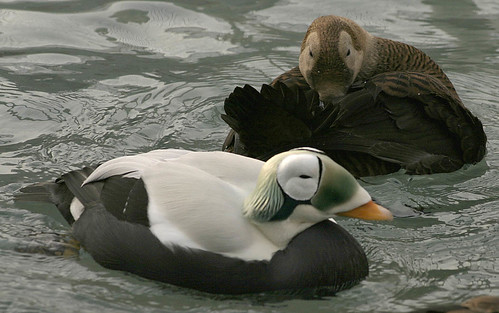
Credit: flickr, Laura L. Whitehouse (USFWS Headquarters).
Status: Threatened
Where to see it: Yukon Delta National Wildlife Refuge (Alaska), Arctic National Wildlife Refuge (Alaska), Alaska Maritime National Wildlife Refuge (Alaska), Togiak National Wildlife Refuge (Alaska)
In winter and spring, the male spectacled eider in full breeding plumage resembles a sea duck from Mars, with its bright orange bill, bold white goggles and wig-like green feathers. Unfortunately, this exotic-looking bird has become extremely rare since the 1970s, prompting its “threatened” listing in 1993. Reasons for this decline are not well-understood, but pollution and lead poisoning from birdshot have been contributing factors. While they spend most of their time at sea feeding on mollusks and crustaceans, the ducks also depend on Alaska’s Arctic coastal plain as breeding ground.
Audubon's crested caracara
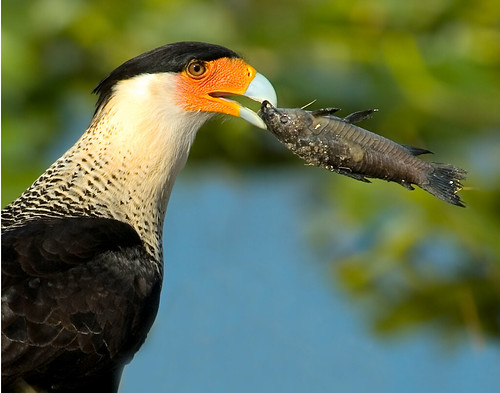
Credit: flickr, ADubin.
Status: Threatened
Where to see it: Arthur R. Marshall Loxahatchee National Wildlife Refuge(Florida)
Audubon’s crested caracara, a large, striking member of the falcon family, can be found in wet prairies and some wooded areas in Florida and the Gulf Coast region, but habitat loss and human interference (especially in the form of motor vehicle traffic) have made it a rarer sight than it used to be. It eats carrion and small animals, part of a diet that is unusually varied for a bird of prey. The way they get that food is pretty unique, too; caracaras have been reported stealing carrion from vultures and other birds, sometimes even in mid-flight.
Ozark big-eared bat

Credit: flickr, U.S. Fish and Wildlife Service - Midwest Region.
Status: Endangered
Where to see it: Ozark Plateau National Wildlife Refuge (Oklahoma).
Befitting its name, the Ozark big-eared bat'shearing organs can reach one-third the animal’s total body length. Fewer than 2,000 of these tiny insectivores are thought to remain in the wild, and while conservationists have worked to restore the species since it was added to the federal endangered species list over 30 years ago, cave vandalism and assorted human disturbance have made it an ongoing challenge. Oklahoma’s Ozark Plateau National Wildlife Refuge was established in 1986 in large part to aid recovery of this and other cave-dwelling creatures.
West Indian manatee

Credit: flickr, Tracy Colson (USFWS Endangered Species).
Status: Endangered
Where to see it: J. N. "Ding" Darling National Wildlife Refuge (Florida), Pine Island National Wildlife Refuge (Florida), Ten Thousand Islands National Wildlife Refuge (Florida), Pelican Island National Wildlife Refuge (Florida), Savannah National Wildlife Refuge (Georgia/South Carolina) and others.
Whether or not this placid coastal river- and estuary-dweller is truly the inspiration for mermaid tales of yore, the West Indian manatee is uniquely beloved, a flagship species for conservationists and Floridians at-large. Like some human inhabitants, the “sea cow” typically spends winters in and around the state, straying west and north when it warms up (in one famous case, the same manatee was spotted in the Chesapeake Bay twice, 17 years apart). Resembling what could be loosely called a sport utility seal, the gentle, bulky creature has benefited greatly from conservation efforts since the 1970s, but is still vulnerable to human-caused habitat loss, boat collisions, entanglement in fishing gear and entrapment in flood gates and canal locks.
Higgins eye pearly mussel

Credit: flickr, Gary J. Wege (USFWS Midwest).
Status: Endangered
Where to see it: Great River National Wildlife Refuge (Iowa/Illinois/Missouri), Upper Mississippi River National Wildlife and Fish Refuge(Iowa/Illinois/Minnesota/Wisconsin).
The Higgins eye is a freshwater mussel that likes deep, relatively gentle water. Though little-noticed, beds of these mussels serve many important roles, including as a food source for raccoons, otters and muskrats; filtering water to improve quality; and providing river-bottom microhabitats for other aquatic life. Populations on the Mississippi River and elsewhere are imperiled by invasive zebra mussels, pollution, dredging, boat traffic and other dangers. Let this serve as a reminder: national wildlife refuges don’t only protect habitat for big or cuddly animals.
While our national wildlife refuges offer great opportunities to see rare plants and animals, preservation of these species for future generations requires that we take precautions not to interfere with them. This means keeping a respectful distance and maintaining healthy habitat by following “leave no trace” rules: never take anything out of a wildlife refuge or leave anything behind.
